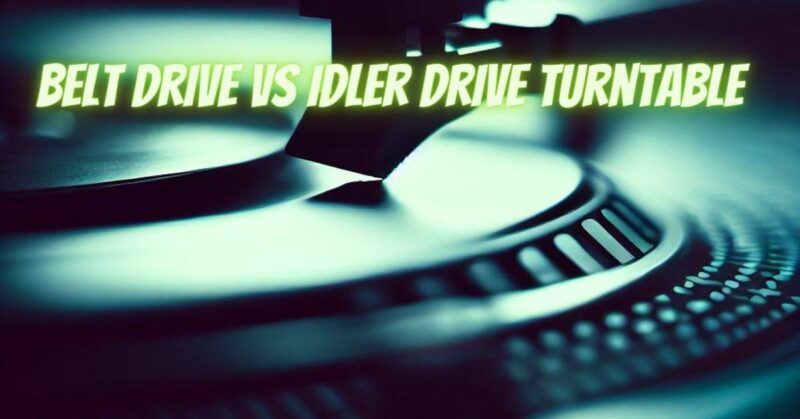In the era of digital music dominance, vinyl records have experienced a remarkable resurgence in recent years. Audiophiles and music enthusiasts alike have rediscovered the warm, analog sound of vinyl, appreciating its authenticity and the immersive experience it offers. A crucial component of the vinyl playback system is the turntable, which comes in various designs, with belt drive and idler drive turntables being two popular options. Each type has its unique characteristics, pros, and cons that can significantly impact the listening experience. In this article, we will explore the intricacies of belt drive and idler drive turntables to help you make an informed decision in your pursuit of the perfect vinyl playback.
- Understanding Belt Drive Turntables:
Belt drive turntables, a design that dates back to the early 1900s, employ a belt to connect the motor and the platter. The motor is situated away from the platter, reducing motor-induced vibrations and minimizing the transfer of vibrations to the stylus. This design aims to enhance overall sound quality, reduce noise, and promote a more accurate reproduction of the music.
Advantages of Belt Drive Turntables:
a. Reduced Vibrations: The primary advantage of belt drive turntables lies in their ability to isolate the platter from the motor’s vibrations, which can contribute to a cleaner, more detailed sound.
b. Lower Noise: The separation of the motor reduces the transmission of mechanical noise, resulting in a quieter listening experience.
c. Stability: Belt drive turntables often have a consistent rotational speed, which ensures steady playback and minimizes wow and flutter (variations in playback speed).
- Exploring Idler Drive Turntables:
Idler drive turntables, on the other hand, feature a rubber or synthetic wheel (the idler wheel) that directly connects the motor to the turntable’s platter. This design was popular during the mid-20th century and is known for its robustness and reliability.
Advantages of Idler Drive Turntables:
a. Instant Start-up: Idler drive turntables offer quick start-up times since the idler wheel can be placed in direct contact with the platter, resulting in almost immediate playback.
b. Strong Torque: Idler drive systems provide high torque, allowing them to handle heavy platters and resist speed fluctuations more effectively.
c. Rugged Build: Idler drive turntables are often more durable and suitable for heavy-duty use, making them an attractive option for DJs and vinyl enthusiasts who require frequent use.
- The Sonics: Belt Drive vs. Idler Drive:
The debate between belt drive and idler drive turntables has long centered on their sonic characteristics. While both designs have their strengths, they impart different nuances to the sound.
Belt drive turntables are often praised for their smooth and refined sound signature. They tend to offer a more delicate and detailed presentation, particularly in the mid and high frequencies. Audiophiles appreciate their ability to retrieve subtle details and achieve a more natural tonal balance.
On the other hand, idler drive turntables are known for their dynamic and impactful sound. The high torque from the idler wheel can provide a tighter grip on the platter, leading to a punchier bass response and a sense of immediacy in the music. Some enthusiasts find that idler drive turntables add a certain “energy” or “drive” to the music.
In the world of vinyl playback, choosing between a belt drive and idler drive turntable ultimately comes down to personal preferences and specific use cases. Both designs have their merits and can offer an engaging listening experience.
If you prioritize precise detail and a smooth, refined sound, a belt drive turntable might be the ideal choice for you. Conversely, if you crave a more robust and dynamic presentation, especially if you intend to DJ or play records regularly, an idler drive turntable could be the better option.
Remember that factors like build quality, cartridge, tonearm, and the overall system setup also play crucial roles in the final sound quality. Whichever turntable you decide on, a well-maintained and properly calibrated setup will undoubtedly elevate your vinyl listening experience to new heights, allowing you to immerse yourself fully in the captivating world of analog audio.

